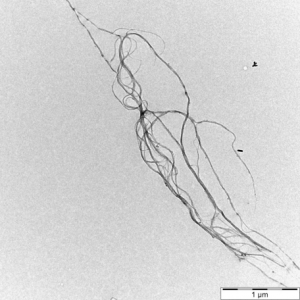In newspapers or on the internet the headline regularly appears saying that nanomaterials behave like asbestos in organisms and induce a rare form of cancer called “Mesothelioma”. What is the story behind such news, and should we be concerned about this?
Fibre dust and the asbestos problem

To answer this question, we should first understand how asbestos affects lung tissue, as this has been investigated very intensely [1]. Asbestos represents a group of fibre-like minerals which mainly consist of silicon with various metals, oxygen and hydrogen. The most important property is the fibrillar consistency which leads to a lengthwise split making the fibres thinner and thinner during aging. If insulation materials contain asbestos, it may happen that during handling such thin fibres are released into the air and can be inhaled if no personal protection equipment is being used. The very thin fibres can deposit deep in the lungs where they interact with the cells and tissue. Due to their length, they will stay for weeks, months or even years (compare section clearance of the lung under Nanoparticles and the lung).
Biopersistent fibres can thus become the cause of an ongoing inflammatory process and result in tumour formation. While lung cancer can have many causes, the otherwise very rare “mesothelioma” is a form of cancer of the lung or peritoneum characteristic of breathing air contaminated with asbestos. Asbestos-related diseases of the lungs are still among the most common occupational diseases – even 30 years after a ban on the use of asbestos in Germany in November 1993. The reason for this is the long incubation period of 30-40 years.
The Fibre Paradigm
For a damaging effect on the cells of the lung, fibers must comply with the so-called “fiber toxicological principle”: they should be elongated and usually significantly longer than 5 µm, very thin (thinner than 3 µm) so that they can enter the deep lung with the air flow, and rigid and biopersistent. Fibers that comply with the fiber toxicology principle can have a carcinogenic effect in humans [2 – 4]. These properties may result in long-lasting (chronic) inflammation of the lung tissue, because after inhalation of the fibres, alveolar macrophages in the lungs try to absorb the fibres and transport them out of the lungs. In this process, the macrophages, as the body’s “waste disposal system”, fail to take up the very long and stiff fibres, resulting in so-called ” frustrated phagocytosis” (see figure). This process, which occurs with certain mineral fibres, including asbestos, and can lead to lung tumours after a long incubation time, can also be observed with certain “nanofibres” with considerably smaller diameters (40 to 100 nm) (see carbon nanotubes) [4].
Thus, reports that all nanomaterials could behave like asbestos are wrong, because dust particles or nanoparticles are usually spherical/irregular and small and are incapable of inducing frustrated phagocytosis as macrophages can take them up and transport them out of the lungs. The clearance is much faster, and no chronic inflammation takes place.
Media error: Format(s) not supported or source(s) not found
Download File: https://nanopartikel.info/wp-content/uploads/2023/06/Makrophage_Test_e.mp4?_=1Schematic representation of phagocytosis of long fibres. The macrophages in the alveoli perform the “al dente” test on fibres, so to speak: Pliable fibres (cooked macaroni) can be fully taken up – analogous to small particles (left), whereas rigid fibres (uncooked macaroni) cannot be fully enclosed by the cell membrane or may even pierce the macrophages and lead to cell stress or cell death (right). © adapted with permission from A. Meyer-Plath (BAuA).
The example of carbon nanotubes elucidated the fact that not all nanotubes exhibit such activity but only the rigid and stable ones which fulfil the “fibre toxicology structure:activity paradigm”. This is the case for very specific carbon nanotubes (e.g., the specially produced MWCNT-7), which have now become a standard model compound for the study of lung disease [5,6].
It can be assumed that the fibre toxicology paradigm has consequences for many fibrous materials, no matter what they are made of. Investigations with different nanowires or nanofibres made of different materials such as silver, nickel, carbon nanotubes, silicon dioxide, titanium dioxide, or cerium oxide showed in principle a comparable toxic effect to asbestos when the fibre geometry was comparable: long fibres (larger than 5 to 10 micrometres) that were also very thin (100 to 300 nm) and stiff produced a strong response in animal experiments or even in cell cultures, regardless of how they were administered [7,8,9,10,11,12,13]. Both inhalation and injection into the pleural space between the lung and peritoneum elicited the same effect in the animal as the long, stiff asbestos fibres [7,8,9,10]. Conversely, it was also the case that short fibres or nanoparticles of the same material (≤ 5 µm), e.g., silver, nickel, silica, titanium dioxide, or cerium oxide but also short asbestos fibres, produced no or very little effect [7,8,11,12,13,14,15].
Taken together, the studies shown here, and many others provide a consistent picture of the effects caused by nanofibres and nanowires. Even if their diameters are very small, the other criteria such as length and stability must be consistent with those of the fibre toxicological paradigm to cause an effect of concern in the animal or cells. This is reflected in the current regulation. In Technical Rule for Hazardous Substances Number 527 of 2020 [TRGS 527, 2020], a guideline value of max. 10´000 WHO-analogous fibres (these are precisely those that satisfy the fibre toxicological paradigm) [16] per cubic meter applies to ALL fibrous substances in the workplace, including nanofibres, as is specified for asbestos fibres as the so-called acceptance concentration for demolition and renovation work [TRGS 519, 2007].
Manufacturers are required to exclude an asbestos-like effect by testing their product, otherwise they must assume such an effect and introduce appropriate protective measures at the workplace or apply the exposure-risk relationship for asbestos [TRGS 527, 2020].
Literature
- Krug, HF et al. (2019).”Fasern und Nanopartikel”, in Toxikologie. Marquardt, Schäfer, and Barth, Eds., 4. ed Stuttgart: Wissenschaftliche Verlagsgesellschaft, pp. 841-869. ISBN:978-3-8047-2876-9.
- WHO (1988).”Man-made mineral fibres and radon” vol. 43. Lyon, France: IARC. ISBN:92 832 12436. download unter https://publications.iarc.fr/_publications/media/download/1592/bddbe727065b1d7fddd8a42fa4e9e9cf758ce65e.pdf
- WHO (1997).”Determination of airborne fibre number concentrations”. Geneva. ISBN:92 4 154496 1. download unter https://apps.who.int/iris/bitstream/handle/10665/41904/9241544961.pdf?sequence=1&isAllowed=y
- Donaldson, K et al. (2010) Part.Fibre Toxicol., 7: 5.
- Moller, P & Jacobsen, NR (2017) Crit Rev Toxicol, 47(10): 867-884
- Sinis, SI et al. (2018) Front Physiol, 9: 295
- Schinwald, A et al. (2012), Part Fibre Toxicol, 9 47.
- Schinwald, A and Donaldson, K (2012), Part Fibre Toxicol, 9 34.
- Schinwald, A et al. (2012), Toxicol Sci, 128(2): 461-470.
- Roberts, JR et al. (2012), J Nanomater, 2012 398302.
- Poland, CA et al. (2012), Nanotoxicology, 6(8): 899-911.
- García-Rodríguez, A et al. (2018), Part Fibre Toxicol, 15(1): 33.
- Ji, Z et al. (2012), ACS Nano, 6(6): 5366-5380.
- Charehsaz, M et al. (2017), Toxicological and Environmental Chemistry, 99(5-6): 837-847.
- Felix, LP et al. (2016), Toxicology Reports, 3 373-380.
- Meyer-Plath, A et al. (2020). “A Practicable Measurement Strategy for Compliance Checking Number Concentrations of Airborne Nano- and Microscale Fibers”, in Atmosphere 11 (11).
Further Information:
- Fibrous Dusts, inorganic, MAK Commission (2017) – download at https://onlinelibrary.wiley.com/doi/epdf/10.1002/3527600418.mb0243fase6519
- TRGS 519 (2007) download at https://www.baua.de/EN/Service/Legislative-texts-and-technical-rules/Rules/TRGS/pdf/TRGS-519.pdf?__blob=publicationFile&v=3l
- TRGS 527 (2020) download at https://www.baua.de/EN/Service/Legislative-texts-and-technical-rules/Rules/TRGS/pdf/TRGS-527.pdf?__blob=publicationFile&v=2
